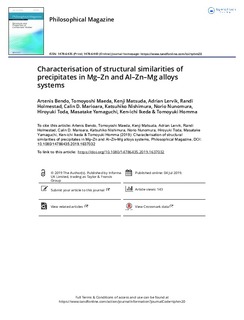| dc.contributor.author | Bendo, Artenis | |
| dc.contributor.author | Maeda, Tomoyoshi | |
| dc.contributor.author | Matsuda, Kenji | |
| dc.contributor.author | Lervik, Adrian | |
| dc.contributor.author | Holmestad, Randi | |
| dc.contributor.author | Marioara, Calin Daniel | |
| dc.contributor.author | Nishimura, Katsuhiko | |
| dc.contributor.author | Nunomura, Norio | |
| dc.contributor.author | Toda, Hiroyuki | |
| dc.contributor.author | Yamaguchi, Masatake | |
| dc.contributor.author | Ikeda, Ken-ichi | |
| dc.contributor.author | Homma, Tomoyuki | |
| dc.date.accessioned | 2019-08-19T10:54:58Z | |
| dc.date.available | 2019-08-19T10:54:58Z | |
| dc.date.created | 2019-07-04T13:22:04Z | |
| dc.date.issued | 2019 | |
| dc.identifier.issn | 1478-6435 | |
| dc.identifier.uri | http://hdl.handle.net/11250/2608987 | |
| dc.description.abstract | High angle annular dark field scanning transmission electron microscopy has been employed to observe precipitate structures in Al–Zn–Mg and Mg–Zn alloys. h1 precipitate structures in Al–Zn–Mg are commonly formed by MgZn2 Penrose bricks, but also frequently observed to incorporate Mg6Zn7 elongated hexagons via two different modes. Tilings of MgZn2 and Mg6Zn7 building blocks in both Beta′ 1 inMg–Zn and eta1 in Al–Zn–Mg alloys, create overall patterns which deviate from the chemical and structural configuration of solely monoclinic Mg4Zn7 or MgZn2 unit cells. Precipitate morphologies were found to be correlated to their internal sub-unit cell arrangements, especially to Mg6Zn7 elongated hexagons. Systematic or random arrangements of Mg6Zn7 elongated hexagons inside precipitates and therefore compositional and structural patterns, were found to be strongly related to the aspect ratio of the precipitates and altering of the precipitate/ matrix interfaces | nb_NO |
| dc.language.iso | eng | nb_NO |
| dc.publisher | Taylor & Francis | nb_NO |
| dc.relation.uri | https://www.tandfonline.com/doi/full/10.1080/14786435.2019.1637032 | |
| dc.rights | Navngivelse-Ikkekommersiell 4.0 Internasjonal | * |
| dc.rights.uri | http://creativecommons.org/licenses/by-nc/4.0/deed.no | * |
| dc.title | Characterisation of structural similarities of precipitates in Mg–Zn and Al–Zn–Mg alloys systems | nb_NO |
| dc.type | Journal article | nb_NO |
| dc.type | Peer reviewed | nb_NO |
| dc.description.version | publishedVersion | nb_NO |
| dc.source.journal | Philosophical Magazine | nb_NO |
| dc.identifier.doi | 10.1080/14786435.2019.1637032 | |
| dc.identifier.cristin | 1710128 | |
| dc.relation.project | Norges forskningsråd: 249698 | nb_NO |
| dc.relation.project | Norges forskningsråd: 197405 | nb_NO |
| dc.relation.project | Norges forskningsråd: 247598 | nb_NO |
| dc.description.localcode | © 2019 The Author(s). Published by Informa UK Limited, trading as Taylor & Francis Group This is an Open Access article distributed under the terms of the Creative Commons Attribution-NonCommercial-NoDerivatives License (http://creativecommons.org/licenses/by-nc-nd/4.0/) | nb_NO |
| cristin.unitcode | 194,66,20,0 | |
| cristin.unitname | Institutt for fysikk | |
| cristin.ispublished | true | |
| cristin.fulltext | original | |
| cristin.qualitycode | 1 | |

